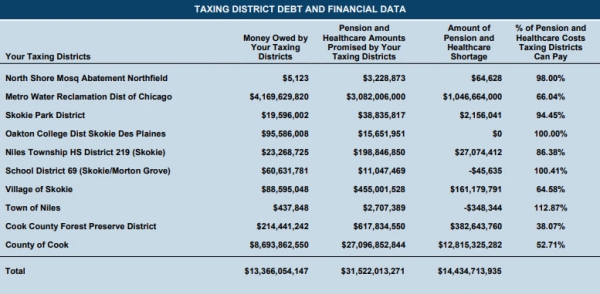Here’s why your tax bill tells you about government debt and pensions
By: Maria Pappas
 I do not determine your property taxes. My job as county treasurer is to bill, collect and distribute that money to pay for local government services. Local governments typically rely on property taxes to fund payrolls and other day-to-day expenses. However, taxing bodies typically borrow money to pay for major projects like replacing a school roof or building a new rec center. Chances are your school board and municipal officials have issued bonds to borrow millions of dollars to be repaid over time. Virtually every unit of government has debt, including unfunded pension liabilities.
I do not determine your property taxes. My job as county treasurer is to bill, collect and distribute that money to pay for local government services. Local governments typically rely on property taxes to fund payrolls and other day-to-day expenses. However, taxing bodies typically borrow money to pay for major projects like replacing a school roof or building a new rec center. Chances are your school board and municipal officials have issued bonds to borrow millions of dollars to be repaid over time. Virtually every unit of government has debt, including unfunded pension liabilities.
At my urging, the Cook County Board in 2009 adopted the Debt Disclosure Ordinance to promote transparency and better inform taxpayers. There are 547 local units of government in the county that set 2,200 different taxing district levies each year. The Debt Disclosure Ordinance requires those agencies provide my office with their most recent audited financial statements and related reports. They also must report all outstanding debts, such as bond issues, as well as pension and other benefit obligations. You can find this information on your First Installment tax bill. The First Installment bills for the 2023 tax year were mailed at the end of January and were due March 1.
These bills tell you the amount of money owed by your taxing districts, the amounts of pension and healthcare costs promised by your taxing districts, the amount of each tax district’s pension and healthcare shortage, and the percentage of pension and healthcare costs that each taxing district can pay.
My website, cookcountytreasurer.com, offers more information about taxing districts to help you understand where your tax dollars go. Click on the purple box that says, “Your Property Tax Overview.” Search using your address or enter your 14-digit Property Index Number (PIN). You’ll see the total debt attributed to your property.
On the left side of the page you’ll see a list of options. If you select, “Taxing Districts’ Financials,” you’ll see the debt and pension amounts from your printed First Installment bills. You can take a deeper dive into financial statements provided by your taxing districts. You can learn annual gross budget revenues for your municipality and school districts, the annual rate of salary increases for public sector employees and a wealth of other information.
Under Pappas Studies you can read debt reports for various fiscal years and explore data for hundreds of schools districts, municipalities, townships and other units of government. Our debt report issued in April 2023 includes a chart that shows total government debt in Cook County grew by 16.5 percent between 2016 and 2021, while the Consumer Price Index increased just 6.4 percent. I encourage you to pay attention to how your local governments are managing debt. I want people to have the information they need to hold their local officials accountable.











